
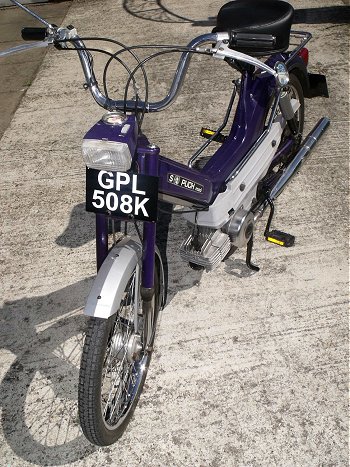
Six months before Neil Armstrong became the first man to walk on the moon, back on Earth, Puch introduced the Maxi to the UK in February 1969, as a basic single-speed automatic pedal moped with rigid frame and telescopic forks. July 1971 brought a swing-arm sprung frame model called the 'S', following which the original rigid frame version continued with an 'N' designation. Early Maxi engines were characterised by mounting the spark plug in the upper side of the cylinder head, possibly not the most efficient placement for best combustion, but later engine versions relocated the plug centrally to the front of the head, and generally the later models seem to perform a little better.
The Maxi however, is quite a durable little machine, and there are still a number of the 'medieval' models still around and, as it happens, IceniCAM has managed to acquire one of these 'old-timer' examples for assessment of 'how things used to be'...
Our feature machine is one of the early 'S' pedal models with spoked wheels and 2.00×17 tyres, K-registration, and dating from 1972. We specifically wanted this exact model as a basis for comparison (you'll find out why shortly), so let's have a look at our traditional original Maxi moped.
The really early rigid Maxis generally came in a choice of red or blue, but introduction of the 'S' brought an enticing new metallic purple colour.
There's not much to say about a Maxi that most readers probably don't already know, since they were made in various forms well into the 1980s, widely sold in huge numbers and are still commonly available today.
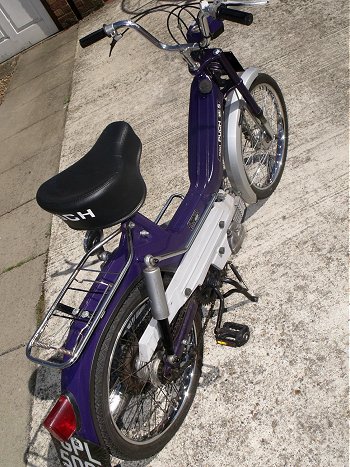
Our test machine mounts the original rectangular headlamp with two-piece shell and 45mph VDO speedometer. A later foam seat replaces the original sprung mattress saddle, which probably fell to bits long ago, but apart from new pedals, a fresh lick of paint, and possibly a few new shiny bits, the bike is fairly representative of how it left the factory.
Most importantly for us, the engine has been rebuilt in original specification with offset plug, so should reasonably represent a good example of the early bike.
Just turn on the fuel, and push down the black choke rod at the left hand side panel.
It may be thought that these early pedal models located the spark plug at the top because they mounted a decompresser valve on the bottom of the cylinder head; but that doesn't quite add up since a centre-plug head was produced later with the decompresser valve still located below.
Pull in a small lever under the left handlebar to engage the starting clutch and decompresser, then either spin the motor on the stand, or pedal up the road for a flying start by dropping the lever to turn and fire the motor.
As you open the throttle, the choke lifts off, so there may be a bit of a flat spot if the motor's not warmed up enough, but Maxi readily pulls away without much real need to pedal assist, and accelerates in phases as the automatic clutching shoes begin to engage and bite.
Our engine pulls steadily up its range, until 24mph, when smooth two-stroke running gets all in a tizzy and collapses into disrupted four-stroking or occasional broken phases of erratic combustion. Whether this effect comes down to overly rich carburetion or inadequate exhaust/transfer porting isn't totally clear, but is not an uncommon experience with the early offset plug motors.
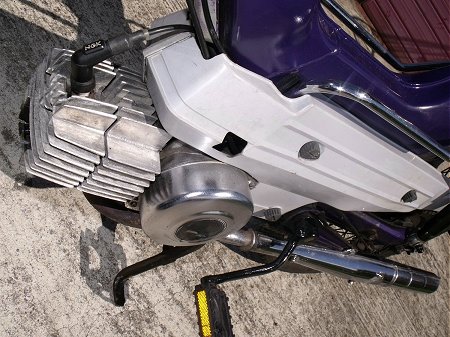
While making these old models generally more unpleasant to ride and dramatically limiting the performance, this four-stroking doesn't appear to compromise their longevity in any way, and the old Maxis just seem to keep trundling slowly but steadily along, year in, year out ... on and on ...
Best on flat 24mph, growling along with four-stroke phasing. Adopting a crouch position makes no difference at all, since a lower profile does not change the overall governing factor that it four-strokes on throttle. Sometimes a headwind and light incline can make the motor work harder, and return combustion to smooth two-stroke running, but it doesn't go any faster, just 24mph.
The only entertainment in this somewhat dull ride, is provided by the VDO speedometer, which swings wildly to indicate between 25 and 40mph at just seemingly tiny fluctuations in speed, while our pace bike rider follows dutifully behind, unable to suppress a thoroughly bored expression. "No, I don't care what the speedo says, it does 24 on the flat, and that's it!"
The downhill run aggravates the motor into more agitated growling as gravity assistance manages to drag our best paced speed up to 28mph, which seems more than the wobbly VDO can cope, since its indication drops back to just 20!
The following uphill climb proves the best part of the ride as the motor comes under load, kicks into clear two-stroke running, and pulls capably up the hill at 21mph. The gutsy ascent gives way to a four-stroking return as the load comes off when we crest the rise, after which we tediously bluster the rest of the way back to base.
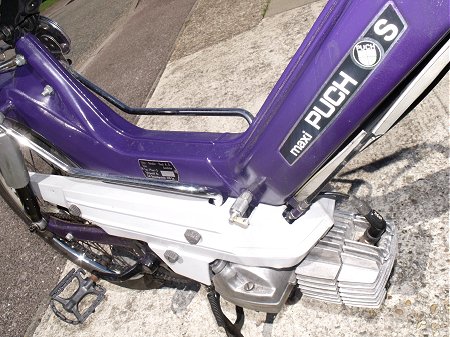
The lights work OK when you switch them on, the horn croaks when you press the button, and the brakes are pretty ordinary but manage all that's required to slow down from the speeds our Maxi does. The suspension takes up most of the worst jolts, but isn't anything other than adequate. The handling is average for a basic commuter-ped.
One really annoying thing about our Maxi, is that when you're stood on the left side of the bike (which is pretty normal for most right handed people), then you can't seem to catch the leg of the stand with your foot from underneath the silencer. It's either reach down with your hand to pull it from under the exhaust, or having to lean over the bike to push down the right hand stand leg. Makes you wonder if the Maxi was designed by a lefty?
That's pretty much it, deadly dull, soulless, completely uninspiring in any way. A simple and reliable tool for plodding about, going to work, down the shops, week in, week out ... on and on ...
And that takes care of how the Maxi came in the good old days...
Like quite a number of traditional pedal mopeds, Puch Maxis have been experiencing something of a popular revival by the young people of our time. Having come full circle, what they now call 'Old Skool mopeds' are apparently quite fashionable once more ... but today, they do things rather differently.
When Puch were making Maxis, there never seemed to be much in the way of tuning equipment available. Basically, you just plodded along with your 50cc moped, until you graduated to a bigger motor cycle, then later a car, while the moped became cheaply sold on to another owner.
Now we'd like you to think of our first feature bike as 'Yardstick', basically a standard pedal Puch Maxi, correctly as the makers intended. The engine in sound mechanical order, the paintwork finished in factory purple, a reasonable example of exactly how anyone should expect a Puch Maxi to be.
It used to be so simple, a Maxi was a Maxi, like every other Maxi, they were all pretty similar; everyone knew where they were ... but not any more! Somewhere along the line, performance kits started appearing, and sometimes things are no longer quite what they used to be ...
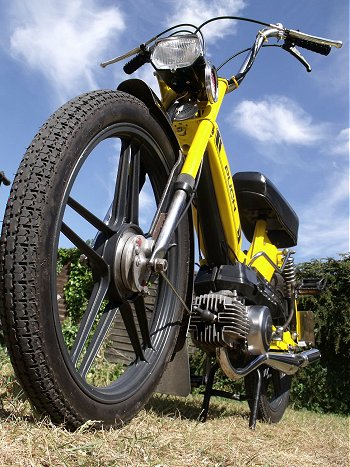
What we have next is a twenty-first century style Puch Maxi - enter 'Mad Max'!
Just like our original example, Max is based on a traditional pedal Maxi-S sprung frame dated 1982, differing little from our previous machine other than being fitted with cast alloy wheels instead of spoked.
The engine, however, is built up with an AJH Athena 70cc 'big-bore' kit with reed valve induction, running stainless steel reed petals and a matching 70 high comp head. The piston is running only a single top ring, so the second slot is left empty. As if that may not be enough, the head is taken down by a further 1mm, so compression ratio is now ... something very high!
There's an extra large bore pipe running to the one-piece chrome expansion exhaust system, and possibly in some token gesture to moderation, the inlet manifold strangely still mounts the original 14mm Bing carburettor.
Presumably intended for the later kick-start version Maxi, the cylinder head has no decompresser, and is not even drilled and tapped to fit one - we guess this is fitted on the basis that if it doesn't have any decompresser, then the valve will never leak?
Other modifications include crankcase transfers matched to the cylinder porting, and a lightened magneto flywheel. We're told the front sprocket remained unchanged (but there's no saying it might have been replaced by a larger one earlier), though the rear wheel was refitted with a smaller back sprocket of 38 teeth (originally 44 teeth), to gear-up the final drive ratio by 13.5%.
No-one can fail to notice either, the glaring 'Chromium Yellow' paint, which simply screams at your eyeballs (so bright it hurts)!
Starting Max is pretty much the same as any normal Maxi, switch on the fuel, push down the choke rod, pull in the clutch lock lever, and kick the pedal ... nope, the clutch slips. Having no decompresser doesn't make it quite so easy to get the motor to spin, so you have to pull in the lever somewhat harder, but on the plus side, you don't have to let the lever go to release the decompresser and hope the motor might start. You can just hold the trigger in and pedal till it fires, so actually, once you've actually got Max to spin, it's possible to keep the motor turning until it catches.
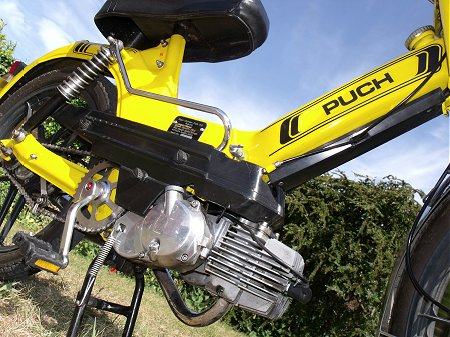
The Tecno Bos expansion proves moderately muffled, so while certainly a little louder and deeper than the original system, the exhaust note is not intrusive, so we're happy with that.
Probably as a combined effect of the absurdly high compression ratio, and running just the one top piston ring, we're warned the motor is quite rattley when cold, but does improve when everything heats up and gets under load. Yes, it certainly does sound rather harsh in there!
Warming the motor a minute until it starts choking up, we tweak the throttle slightly to lift off the choke and let the engine breath, then nudge off the stand and gingerly edge away from the kerb. Effects of the raised drive ratio are particularly apparent when pulling off, and one can't help but feel for the tortured clutch which is working really hard with the single-speed automatic drive in this initial phase. You can at least give a boost on the pedals if you're feeling sympathetic.
Because of the raised gear ratio, the auto clutch doesn't begin to bite until 20mph, and though there's appreciably more than a standard pull once the shoes have engaged, the motor doesn't really start to urge until the revs get up and porting comes on around 30mph ... just about the point when a standard Maxi is beginning to run out, then things really start to happen on Max!
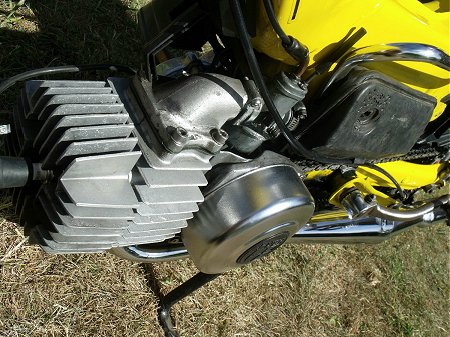
Now you're in the power band, winding the throttle delivers a mighty pull ... the speed keeps on building, easily past 40, and you wonder where it's going to stop? There's a strange unreality about the situation as we cruise into a strong headwind between 35 and 40 on the clock, and there's still plenty left on the throttle!
We only get up to 51mph on our first flat run, as a few light bends in the road and buffeting crosswinds reveal the wavering and weaving limits of the Puch Maxi-S frame when pushed into realms it was never meant to go. The twitchy ride is Scary with a capital S, and we back-off knowing we've barely glimpsed its potential!
It's pretty obvious that serious speed running is only going to be safely possible under straight and favourable conditions; otherwise we really are going to courting disaster.
With its flexi pressed-steel swing arm, Max proves far too twitchy to consider blasting the downhill run on our usual test circuit, because a light bend in the lower section kicks us into a weave at just 40mph, so we daren't even open up until two-thirds of the way down after we exit the curve. It's rarely any problem on most bikes we test, but this ride has a whole new dimension!
Piling on the throttle into the lower section, our pacer clocks us through the dip at 45, if only to see how much pace Max loses on the following climb - except it doesn't quite work like that.

In defiance of the laws of moped science, Max actually accelerates up the hill and crests the rise at 49!
It's not certain that anything like this has quite been known before?
Taking a bravery pill, we decide to try for a top speed run on a flat straight with a strong tailwind. Tucked down into a crouch, pointing firmly ahead through the twitches and weaves, while hanging on for dear life through the Puch's howling protestations, we find Max's peak at 55mph. The top speed is held here by rev-clipping, limited either by running out of carburetion or flutter in the stainless reeds. Possibly a larger carburetter and carbon fibre reeds would enable the motor to even greater heights, but Max is already quite capable of pushing the danger factor well beyond sensible.
On the fast run, the following pacer chose to maintain a discrete gap, not wishing to risk any tangle with potential disaster as Max weaved menacingly down the strip.
It's not just the handling to take into account, there are also the brakes! The standard Maxi brakes will only operate at their normal capable rate - they were never intended to cope with anything like this, and quite honestly, they don't! Sure, they'll slow you down, but they're never going to pull you up in time if you really need to stop. The only precaution is to plan well ahead, and judicious use of the brakes at speed is also recommended, since they can easily throw Max into some over exciting reactions that you'd generally prefer to avoid.
The 45mph VDO speedo is much like the rest of the fixtures and fittings, and completely fails to keep up with the bike's performance.
We wondered how the light bulbs might cope with such an unstabilised AC voltage surge at the revs this motor hits? The answer is probably just briefly ... supernova, then darkness ...
The horn produced no more than a feeble croak - we guessed that might have been fried already!
Following the takeover of Puch by Piaggio in mid-1987, the Maxi model range was discontinued in September 1987.
Next - Now if the Top Gear boys were to end the show with "next week we'll be testing a Mitsubishi and a Subaru", then everyone would be probably be thinking of an Evo and a Scooby, superfast modern competition sports cars with smoking tyres and screaming exhausts ... but this is IceniCAM, not the BBC.
Yes, we may be testing Mitsubishi v Subaru. There may well be smoking tyres and screaming exhausts, but any further similarity probably ends there - from our new Samurai cyclemotors in Rapiers at Napier.
In with this crazy production on rear mounted cyclemotors, and just for a bit of contrasting sanity, we're even including a couple of old timer Cyclaids. Four feature machines in one article!
You've probably worked it out by now, that IceniCAM special edition 22 is going to be largely based on bikes in New Zealand!
[Text © 2012 M Daniels.]
Dear Mark,
I read your brilliant article on the two Puch Maxis and offer my humble opinion on the four-stroking problem on he 1972 machine. My Maxi is a 1982 model but similar engine design with valve lifter, etc. I refurbished the engine: new seals, rings, etc, set the ignition spot on and had the carb cleaned locally but found that on about three-quarter throttle it four-stroked like mad (at about 22mph).
So, I experimented with the air-cleaner, bearing in mind that four-stroking is a result of the mixture not burning fully due to reduced percentage of air to oxygen. I found, after several trials, that by removing the little air-intake tube completely from the air-filter box the engine ran perfectly all the way up to full throttle (flat out over 30mph) two-stroking all the way. Try removing the little ribbed air tube and see if your engine runs correctly.
Keep the articles coming. They are really good.
Thank you,
John Williams.
Puch Maxi's really aren't meant to do 55mph and we've got to say, there's quite a degree of unpredictability about doing this sort of thing. You've got to be partly barmy to want to produce a machine like Mad Max, but owner Mick Cook is no stranger to craziness! 'Cookeye' has some previous in this department, and is credited as the same raving nutter who produced our 172cc Aprilia powered 'Alien' Suzuki Street Magic for the Monkey Business article back in July 2009.
Anyone who thinks doing 160mph on a modern superbike might be an exhilarating experience, has no idea how scary 55mph on a sprung frame Puch Maxi can be. You can very quickly appreciate that both these vehicles are equally quite capable of killing you, it's just that the Maxi is much closer to the edge. The nervous handling, combined with rev vibration, a rattley and clattery overtuned motor that feels and sounds like it could let go at any time and ineffective brakes, just seems the perfect combination for courting disaster.
We did the glaring Chromium Yellow (custom paint by Neil Bowen) Mad Maxi test first, in May 2011, photoshoot, road test notes, all in the can, but it took a little thinking about how we might present it?
It just a matter of waiting for inspiration to come ... in the form of seeing Douglas Dalziel plodding round an East Anglian Cyclemotor Club run on his old-timer Maxi. That's what we need, Dougy's old 'yardstick' Maxi! Before and after!
The purple Maxi turned up for test in August 2011, exactly the same week as the Mercury Grey Streak, and both were tracked round the course on the same day by the pace bike. In contrast to the Streak run, the old purple Maxi was totally reliable, miserably slow, and predictably dull - absolutely everything that we expected of it, but an ideal foil for the ballistic yellow missile.
Once we rode Dougy's old purple Maxi, it was fairly obvious it wasn't going quite properly, far too rich on the mixture, but that was how it came, so that's how we ran it. The bike went through the workshops after the test, and the rich running turned out to be a combination of the choke shutter not lifting off properly, and a crushed intake pipe on the airbox. A few simple tweaks and it was revving out again, top speed now well up to 30+.
Production costs for the Mad Max article were negligible since both bikes came from just five miles down the road in Felixstowe, while collections and returns were incidental when the van was passing by anyway.
Sponsorship for the article was collected by Martin Austin at YPVS (Yamaha, Puch, Vespa Spares), since the feature seemed to suitably fall under his umbrella of parts supply and moped tuning components. YPVS sells a wide selection of various standard and go-faster Puch parts if you fancy a bit more power, many of which are more 'moderate' than the Athena kit, which is one of the more radical conversions.